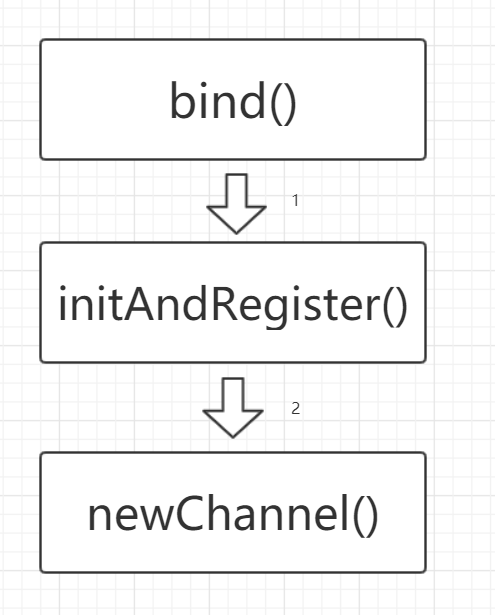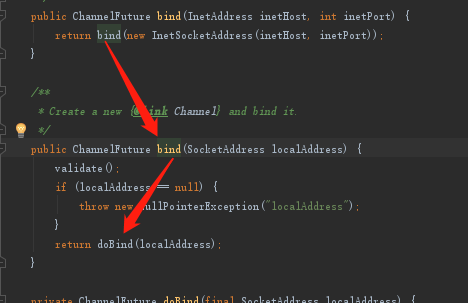前言
本文就来来记录一下我们在启动Netty时,底层大概都做了哪些事情。不过因为我对Netty还只是刚刚入门,可能会跳过某些细节,也有可能会有写错的地方,如果漏了或错了,日后发现会进行补充或改正。
我将Netty启动简单分为了四个阶段,每一篇记录一个。
Netty version:4.1.6
先贴下代码
Server
import io.netty.bootstrap.ServerBootstrap;
import io.netty.channel.*;
import io.netty.channel.nio.NioEventLoopGroup;
import io.netty.channel.socket.SocketChannel;
import io.netty.channel.socket.nio.NioServerSocketChannel;
import io.netty.util.AttributeKey;
public final class Server {
public static void main(String[] args) throws Exception {
// 两大线程
// 对应Socket中Server的启动监听线程
EventLoopGroup bossGroup = new NioEventLoopGroup(1);
// 对应Socket中Client中主函数的线程
EventLoopGroup workerGroup = new NioEventLoopGroup();
try {
// 辅助类
ServerBootstrap server = new ServerBootstrap();
// 装配线程
server.group(bossGroup, workerGroup)
// 设置Channel的类型
.channel(NioServerSocketChannel.class)
// 给每个客户端的连接设置一些tcp的基本属性
.childOption(ChannelOption.TCP_NODELAY, true)
// 每次创建客户端时,绑定一些基本的属性
.childAttr(AttributeKey.newInstance("childAttr"), "childAttrValue")
// 服务端启动时做的逻辑
.handler(new ServerHandler())
// 给pipeline配置handler,Channel发生某种变化时对应的处理逻辑,todo 幕信里就写了一条链
.childHandler(new ChannelInitializer<SocketChannel>() {
@Override
public void initChannel(SocketChannel ch) {
// 往pipeline中添加Handler
//ch.pipeline().addLast(new AuthHandler());
}
});
// 辅助类,绑定端口,这里使用了同步
ChannelFuture future = server.bind(8888).sync();
// 关闭
future.channel().closeFuture().sync();
} finally {
bossGroup.shutdownGracefully();
workerGroup.shutdownGracefully();
}
}
}
代码中的ServerHandler可以无视,因为追踪时暂时不会用到,所以暂时不贴。
下面的代码分析记录都是根据上面的代码。
启动的四个阶段
- 创建服务端Channel(<--本篇)
- 创建服务端Channel
- 注册selector
- 端口绑定、通知
创建服务端Channel
大致流程:

从上面Server代码中的bind()这一段开始追踪:
ChannelFuture future = server.bind(8888).sync();
进入bind()函数后,连跳,看到doBind():

进入doBind(),看到第一行如下,找到了流程第二步:
final ChannelFuture regFuture = initAndRegister();
再进入initAndRegister(),找到如下一段,这段就是创建Channel的核心:
channel = channelFactory.newChannel();
再进入newChannel(ReflectiveChannelFactory),发现底层是通过反射调用无参构造函数的:
return clazz.newInstance();
虽然知道是通过反射构造的,但具体是哪个类呢?其实这个在我们写代码的时候自定义了,视角回到上面的Server的一段代码:
.channel(NioServerSocketChannel.class)
我们进入channel(),可以看到:
public B channel(Class<? extends C> channelClass) {
if (channelClass == null) {
throw new NullPointerException("channelClass");
}
return channelFactory(new ReflectiveChannelFactory<C>(channelClass));
}
可以看到:
- 其实是将我们设置的类,经几度包装最终返回一个channelFactory,也就是上面使用反射时构造的类。
- channelFactory()函数没有什么特别操作,就是转下类型,所以我们应该将重点放到ReflectiveChannelFactory的构造函数上。
服务端创建Channel其实到反射调用构造那里就已经结束了,下面只是继续探究ReflectiveChannelFactory的构造函数到底做了什么。
ReflectiveChannelFactory构造函数
先展示一下大致流程:

图中的方法暂时先忽略参数。
现在,我们先进入NioServerSocketChannel的构造函数:
public NioServerSocketChannel() {
this(newSocket(DEFAULT_SELECTOR_PROVIDER));
}
再进入上面的newSocket()函数:
private static ServerSocketChannel newSocket(SelectorProvider provider) {
try {
return provider.openServerSocketChannel();
} catch (IOException e) {
throw new ChannelException(
"Failed to open a server socket.", e);
}
}
可以看到方法参数是SelectorProvider,返回值是ServerSocketChannel,这两是jdk的类,说明此处Netty是调用jdk的接口去创建类的,只是后来再进一步封装。(两个class都是jdk 1.4后引入的nio)
现在将视角转回最初的NioServerSocketChannel无参构造函数,进入this(),我们可以看见config类NioServerSocketChannelConfig,由于我们上面的Server代码设置了tcp,所以这里的配置类会帮我们初始化tcp的一些参数:
/**
* 位置:io.netty.channel.socket.nio.NioServerSocketChannel#NioServerSocketChannel(java.nio.channels.ServerSocketChannel)
**/
public NioServerSocketChannel(ServerSocketChannel channel) {
super(null, channel, SelectionKey.OP_ACCEPT);
config = new NioServerSocketChannelConfig(this, javaChannel().socket());
}
然后,我们进入super函数:
protected AbstractNioMessageChannel(Channel parent, SelectableChannel ch, int readInterestOp) {
super(parent, ch, readInterestOp);
}
继续super:
protected AbstractNioChannel(Channel parent, SelectableChannel ch, int readInterestOp) {
// parent为null,parent是给客户端channel存储服务端channel的
super(parent);
this.ch = ch;
this.readInterestOp = readInterestOp;
try {
// nio关键,就是这里设置了非阻塞I/O
ch.configureBlocking(false);
} catch (IOException e) {
try {
ch.close();
} catch (IOException e2) {
if (logger.isWarnEnabled()) {
logger.warn(
"Failed to close a partially initialized socket.", e2);
}
}
throw new ChannelException("Failed to enter non-blocking mode.", e);
}
}
其中ch.configureBlocking(false);就是负责配置非阻塞I/O。
再super,可以看到此处最终完成了AbstractChannel的构造:
protected AbstractChannel(Channel parent) {
// parent为null,如果是客户端channel则不同
this.parent = parent;
id = newId();
// 返回NioMessageUnsafe(服务端),如果是构造客户端channel,则返回NioSocketChannelUnsafe
unsafe = newUnsafe();
pipeline = newChannelPipeline();
}
以上就是Netty服务端创建Channel的过程了,虽然暂时忽略了一些细节,不过算是对流程有一个大概的认识,如果之后有更多参考资料,会继续补全。
关于提到的客户端channel,其实就是是NioSocketChannel,有兴趣的可以自己追下它的构造方法,我会在后面遇到的时候再写博客记录。